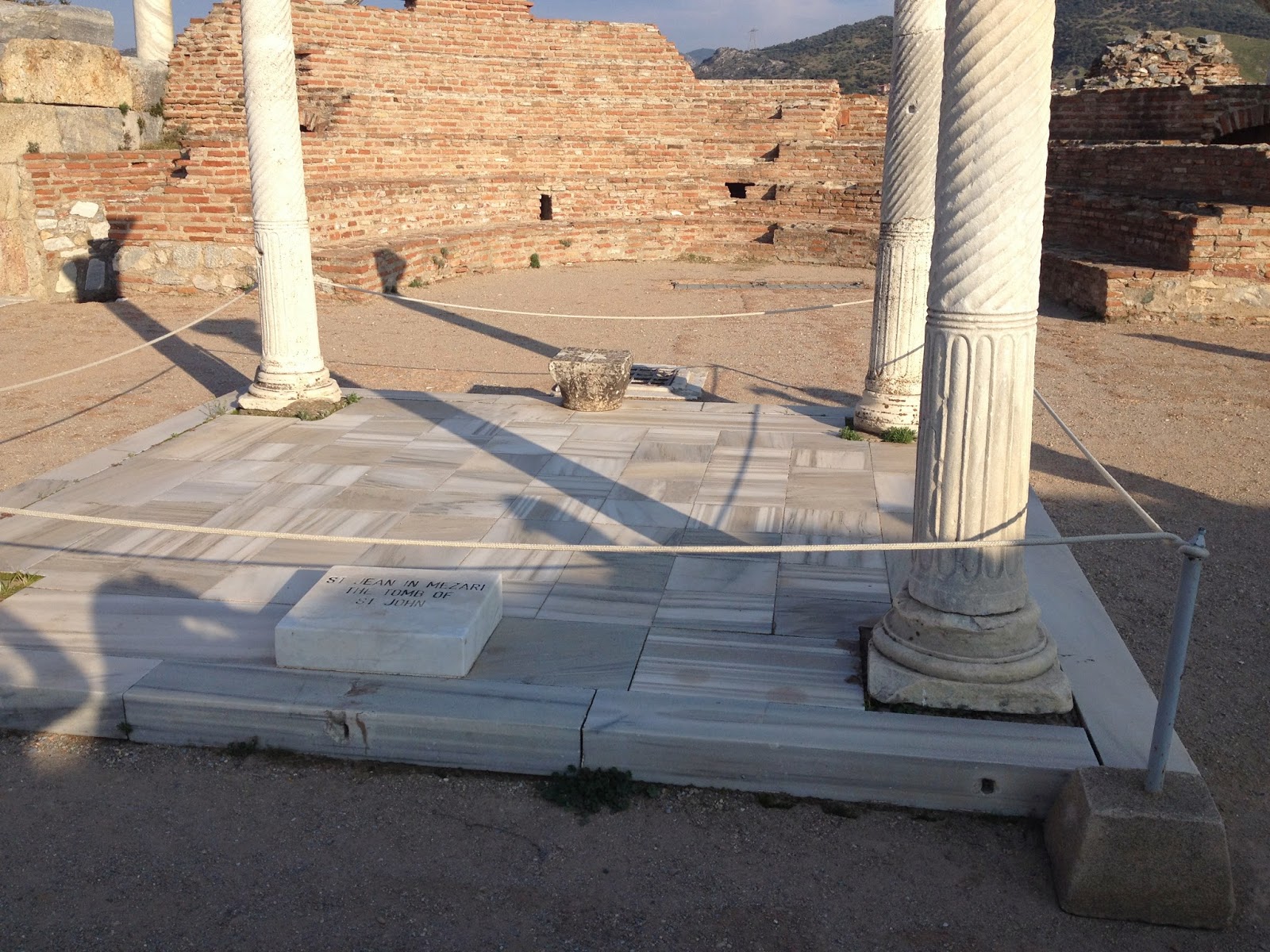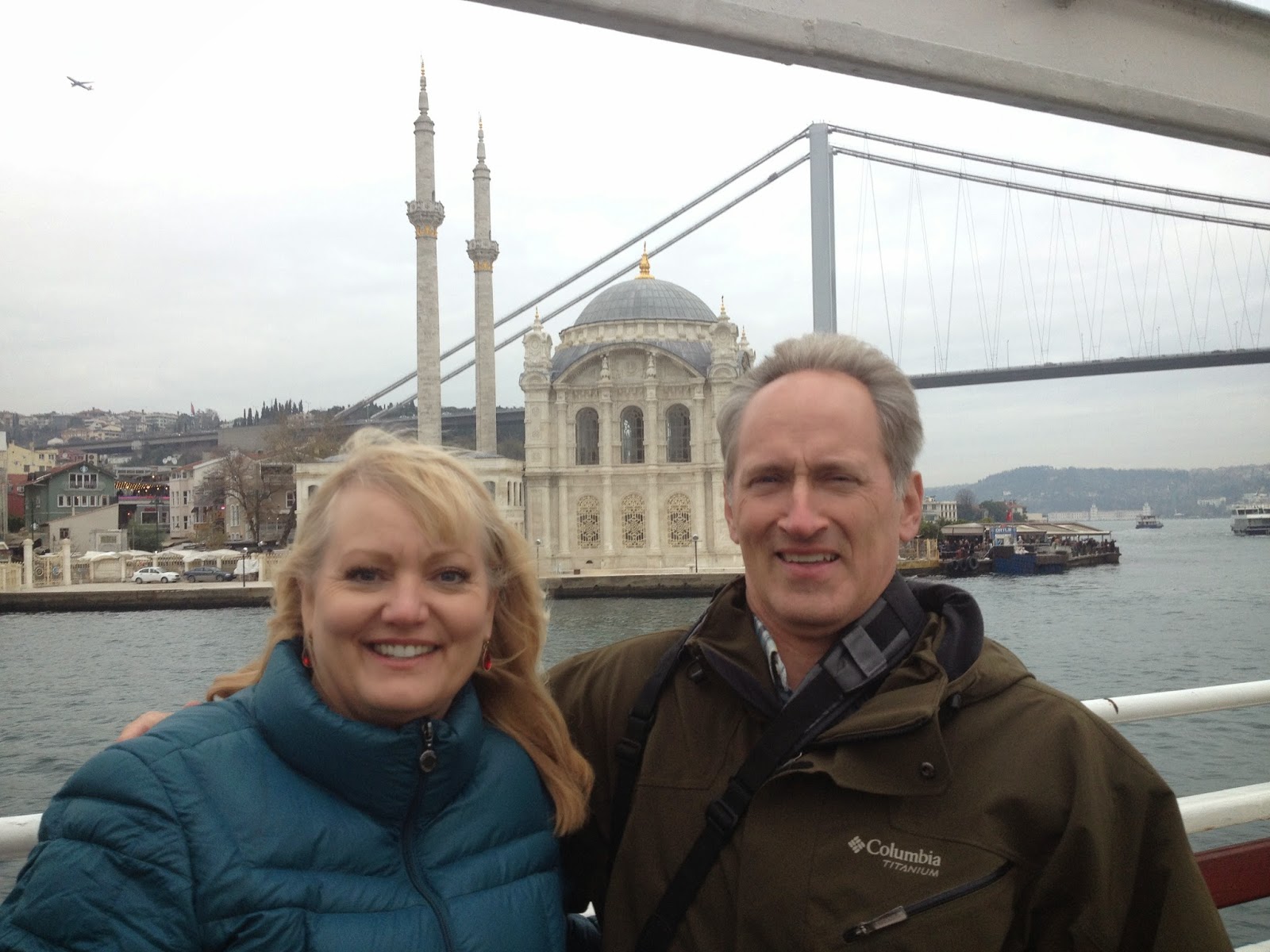They would build city upon city.
Those little markers you can see are the different levels of the city. They figure there's a thousand years between each layer.
Every city in Turkey has an amphitheater.
Just a cute tourist attraction in Troy.
Next we went to Pergamum. It was a powerful kingdom during the ancient Hellenistic period. It was considered the medical center of the world. It was here that a man (Hippocrates?) discovered that blood flowed through the body.
See that Acropolis on the hill in the above picture? Acropolis means: "high city." The one in Greece gets all the attention, but there are many all over the place.
This is the "road" to the medical center. I tell you -- you can't believe the marble EVERYWHERE.
So it was here that maybe Hippocrates studied.
The picture below is a tunnel where mentally ill people were kept. (I'm right at home, eh?) The holes in the ceiling are where the doctors would converse with them.
Here is the tunnel where the schizophrenics would enter.
That fountain below is still flowing as it did thousands of years ago. The water cascaded down the stairs and into the aforementioned tunnel. It made quite a soothing sound and would calm the people down. It was actually quite pretty.
Seriously, an amphitheater on every corner like we have 7-11's.
At his place there was a carving on marble of two snakes with their heads over a bowl. One doctor hypothesized that snake venom might have some medicinal properties but he didn't have the courage to try it. One sick man wanted to commit suicide, so he ingested venom and got well! Funny that today the symbol of medicine is two snakes intertwined. It started here!
We drove to Kusadasi tonight. Okay - let me tell you how to pronounce that correctly. (Turks hate it that we Americans butcher the name.) It's: koo-sha-DES-a.
First tour of the day was to see the House of Virgin Mary. (picture below) It is believed to be the place where John brought Mary to live out her days. A lot of Christ's apostles went to Turkey and we know that John did also. And he was entrusted to care for Mary, so . . .
I filled up a water bottle of "sacred" water from the spring that still flows there after all these years.
(above: the sacred springs)
Below: people leave notes (like at the Wailing Wall).
Next stop: Ephesus
Our guide kept commenting on how nice it was there that day. Usually it is hot and super crowded. We had cool weather and no crowds. "Actually, unbelievable."
Capstones everywhere.
The famous library below.
Below: the huge theater (largest in Asia Minor) where the Apostle Paul tried to preach. Because the silversmiths made their living selling statues of the goddess Diana (Artemas), they couldn't have someone preaching Christianity and ruin their livelihood. They yelled at him for two hours. He was detained for 7 days and then he left for Macadonia.
Ephesus had marble toilets (for the men) with water running underneath. And the pipes were made out of terracotta. Naturally, this was only for the upper-class people, but I wonder how in the world did outhouses ever exist when this "technology" was available thousands of years ago??
The Library
Above: our hotel in Kusadasi. (say it right!)
Below: the view from our room.
Next stop was where the Apostle John is buried. (below)
And below is a baptismal font. Steps leading down to it from both sides. They believed in baptism by immersion. Imagine that!
Our driver also showed us where the Grotto of the Seven Sleepers was. The Muslim people in our group were very interested in that. The legend is that the Apostle Paul left seven believers in Ephesus when he was forced to leave. They stayed in a cave to hide. They slept and then the next morning when they were hungry, they gave one man some coins to go into town to buy bread. When he went to pay, they didn't recognize his money and asked where he got it. They finally concluded that the men had slept for 300 years and now everyone was Christian. (cue the Twilight Zone music)
The next morning we left for Pamukkale. (pom-OO-koo-lay)
We first visited the thermal hot springs. (You should check out the pictures on Google. Amazing!) They have served as a therapeutic thermal bath since the 2nd century BC.
We had to walk barefoot on the calcium travertines. The water is nice and warm. It used to be in the city of Hieropolis. Here is the largest cemetery in Asia Minor. People would come from all over to bathe in the "healing waters." Consequently, that contributed to the huge cemetery. :-)
There is a chapel (ruins) here dedicated to the Apostle Phillip. Never mind that they stoned him here...
I love that we could walk all over this place. In the United States, they would most likely ban it, or they would put up fences, or some other such nonsense. The place looks likes its covered in snow because the calcium is so white. It's hard to see here, but the water was really pretty blue.The next day we drove to Konya. Enroute, we stopped for a snack that our guide recommended. It was yogurt with honey poured over it and sprinkled with golden poppy seeds. (picture below) It was delicious! The yogurt over there is SO much better than here.
And while we were stopped at this place (below) it started to snow.
So Konya is known as a very conservative city. No alcohol. It was founded in 3500 BC. The Apostle Paul was stoned here, so he left. This is the land of the Whirling Dervishes. It's not a dance, it's a form of meditation.
We went to the Mausoleum of Mevlana. Rumi is buried here. He was born in 1207 in Afghanistan. His father was a well-known Muslim scholar. They left Afghanistan when he was 14. Rumi is not his real name, but its too hard to pronounce. Rumi means: land of the Romans. Apparently, his books (teachings) are still best sellers.
We couldn't take pictures inside the turquoise-domed room. He is in a sarcophagi and it was pretty stunning. He was laid by his father and legend says the next morning his father's tomb was standing on it's end, representing that he was bowing to his son who is greater.
The writings on the walls are mirror-imaged to show we are the mirror image of God. Of which they don't believe in. (Don't get me started.)
Next day: on to Cappadocia.
We went over a snowy mountain pass. Our bus driver was amazing. As you can see below, the other side of the road was closed down. Poor people.
Enroute, we stopped at the Caravanserai of Sultanhan. (below) This was a building along the silk road that the caravans would overnight at. They would pay for protection. The camels would be inside the walls (open air) and the people would be underneath a roof. There was one of these buildings every 30-40 kilometers. They were called Sari's. Means: "palace." They were all identical. There was a dome in the middle so that one could see it from miles away. This particular one was built in the 1220's. Perhaps even Marco Polo stayed at this one.
Then we stopped at a school that our tour company - Gate 1 - helps sponsor. Cute and friendly kids.
Cappadocia - "land of the beautiful horses" is famed for it's temples and houses cut directly into the region's spectacular rock formations.
They call these sandstone formations "fairy chimneys."
People actually lived in these until 1982! And tourism started here in 1985. Did you know that the potters wheel was invented here?
There are four crops here in the city: potatoes, pumpkin seeds, grapes and apricots. They have underground cellars and keep potatoes and lemons in there.
The picture above is of the Rock Churches. They also served as their homes. When Constantine ruled and the whole country was Christian, they lived and worshiped in the same places. Long tables were cut into the limestone and there were many paintings on the ceilings. One showed Christ after he had died, breaking the locks on the door of hell and standing on Satan's head and setting Adam and Eve free. And as I thought every single day while there: how in the world did this country turn Muslim? Oh yeah -- the sword. One of the paintings in this place is believed to have been painted by Luke.We went to a carpet atelier to have a demonstration of carpet weaving. I loved that there was no hard sell afterwards. (Yeah, I did pick out a gorgeous 30 thousand dollar blue one. Did I buy it? Are you kidding me? No.)
Watching how they make carpets was truly amazing. The silk starts out in cocoons of course, but the demo on how they get the threads off was educational. It involves soaking them in really hot water and then using that whisk broom thingy you can see below. Did you know that ONE of those tiny cocoons gives 100 miles of silk thread? It's the strongest fiber in the world and the marble artisans used the thread to cut marble. I know!
A painting in our hotel lobby. (Dinler Hotel) Our 5 star hotel lobby mind you.
We also toured an underground "city." Invading Arabs forced the people into underground "bunkers." There were a lot of vents to the outside disguised with rocks around them. The people AND their animals could live there for 3 months. We went in quite a ways and I didn't get too claustrophobic, but I don't know what would be worse -- Arabs or staying in there. There are hundreds of those underground caves. Same temperature - doesn't matter what month it is.
On to the Valley of the Lovers:
With our friends Peter and Trisha Chang. A super fun couple in our group from New York. We loved hanging out with them.
Just thought it was funny.
The food at this hotel was amazing. And they make it look so pretty too.
A mosque on every corner . . .
Our guide Aykut. (eye-koot) He was great. Made the trip so fun. And oh my gosh -- he knows his history about Turkey. It was quite impressive.
I have more to write. This trip is still not done.






























































